Assessment of Typhoon Precipitation Forecasts Based on Topographic Factors
Abstract
:1. Introduction
2. Data and Methods
2.1. Data
2.2. Method
3. Statistical Characteristics of Precipitation and Forecasting Tests for Different Terrains
3.1. Distribution of Cumulative Typhoon Precipitation
3.2. Categorizing Precipitation Patterns and Biases
3.3. Evaluating Cumulative Precipitation Based on Traditional Method
3.4. Evaluating Neighbourhood Cumulative Precipitation
4. Conclusions and Discussion
- (1)
- Compared to the experiment before the improved topography, the model after the improved topography simulated more precipitation. The improved experiments consistently simulated the area of large-value cumulative precipitation during the study period and were more in line with the observations. The temporal trend of the three-hourly cumulative precipitation was more consistent with the observed precipitation. Typhoon HAGUPIT had the best modelled change in three-hourly cumulative precipitation among the four individual typhoon cases.
- (2)
- The simulated precipitation deviation was smallest for Typhoon HAGUPIT and largest for Typhoon LEKIMA. Reducing the degree of terrain smoothing can mitigate the model’s simulated precipitation bias for Typhoon LEKIMA, but it may inadvertently increase the model’s precipitation bias for other typhoon individual typhoon cases. The influence of topographic factors is evident as simulated precipitation deviations are consistently larger in mountainous areas than in flat areas. However, the precipitation deviations on the windward and leeward slopes vary among different typhoon events.
- (3)
- Improved terrain not only enhances the number of hits but also reduces the spatial bias in typhoon precipitation, thereby improving forecasts. The topographic differences between flat and mountainous terrain are much more pronounced than the effect of topographic differences between the windward and leeward slopes on model-simulated precipitation. There is a significant bias in the spatial distribution of precipitation over mountains, and the model provides better precipitation simulations for flat terrain. The impact of the windward and leeward slopes on precipitation simulation varies among different typhoon cases. Precipitation simulations for a wide range of terrains with large precipitation thresholds are slightly inadequate. However, for Typhoon HOTA, after improving the terrain to enhance its precipitation simulation, it has the capability to forecast heavy rainfall scenarios in mountainous areas.
Author Contributions
Funding
Institutional Review Board Statement
Informed Consent Statement
Data Availability Statement
Conflicts of Interest
References
- Lackmann, G.M. Hurricane Sandy before 1900 and after 2100. Bull. Am. Meteorol. Soc. 2015, 96, 547–560. [Google Scholar] [CrossRef]
- Wang, D.; Wang, X.; Liu, L.; Wang, D.; Huang, H.; Pan, C. Evaluation of CMPA precipitation estimate in the evolution of typhoon-related storm rainfall in Guangdong, China. J. Hydroinform. 2016, 18, 1055–1068. [Google Scholar] [CrossRef]
- Abancó, C.; Bennett, G.L.; Matthews, A.J.; Matera, M.A.M.; Tan, F.J. The role of geomorphology, rainfall and soil moisture in the occurrence of landslides triggered by 2018 Typhoon Mangkhut in the Philippines. Nat. Hazards Earth Syst. Sci. 2021, 21, 1531–1550. [Google Scholar] [CrossRef]
- Gao, Y.; Zhang, Y.; Lei, L.; Tang, J. Multi-scale characteristics of an extreme rain event in Shandong Province, produced by Typhoon Lekima (2019). Front. Earth Sci. 2023, 10, 1093545. [Google Scholar] [CrossRef]
- Wu, Y.-C.; Yang, M.-J.; Rogers, R.F. Examining Terrain Effects on the Evolution of Precipitation and Vorticity of Typhoon Fanapi (2010) after Departing the Central Mountain Range of Taiwan. Mon. Weather Rev. 2022, 150, 1517–1540. [Google Scholar] [CrossRef]
- Fang, X.; Kuo, Y.-H.; Wang, A. The impacts of Taiwan topography on the predictability of Typhoon Morakot’s record-breaking rainfall: A high-resolution ensemble simulation. Weather Forecast. 2011, 26, 613–633. [Google Scholar] [CrossRef]
- Yang, M.J.; Zhang, D.L.; Tang, X.D.; Zhang, Y. A modeling study of Typhoon Nari (2001) at landfall: 2. Structural changes and terrain-induced asymmetries. J. Geophys. Res. Atmos. 2011, 116, D09112. [Google Scholar] [CrossRef]
- Li, D.Y.; Huang, C.Y. The influences of orography and ocean on track of Typhoon Megi (2016) past Taiwan as identified by HWRF. J. Geophys. Res. Atmos. 2018, 123, 492–511, 517. [Google Scholar] [CrossRef]
- Cho, W.; Park, J.; Moon, J.; Cha, D.-H.; Moon, Y.-m.; Kim, H.-S.; Noh, K.-j.; Park, S.-H. Effects of topography and sea surface temperature anomalies on heavy rainfall induced by Typhoon Chaba in 2016. Geosci. Lett. 2022, 9, 29. [Google Scholar] [CrossRef]
- Liu, J.; Li, Z.; Xu, M. Analysis of terrain height effects on the asymmetric precipitation patterns during the landfall of typhoon Meranti (2010). Atmos. Clim. Sci. 2019, 9, 331. [Google Scholar] [CrossRef]
- Yu, Z.-f.; Yu, H.; Gao, S.-t. Terrain impact on the precipitation of landfalling Typhoon Talim. J. Trop. Meteorol. 2010, 16, 115. [Google Scholar]
- Ping, O.; Yong-Qing, W.; Xiu-Nian, Z.; Li, T. A Numerical Study of Mesoscale-Topography Influence on the Heavy Rainband of Typhoon Hato (2017). J. Trop. Meteorol. 2021, 27, 393–405. [Google Scholar] [CrossRef]
- Jolliffe, I.T.; Stephenson, D.B. Forecast Verification: A Practitioner's Guide in Atmospheric Science; John Wiley & Sons: Hoboken, NJ, USA, 2012. [Google Scholar]
- Brill, K.F.; Mesinger, F. Applying a general analytic method for assessing bias sensitivity to bias-adjusted threat and equitable threat scores. Weather Forecast. 2009, 24, 1748–1754. [Google Scholar] [CrossRef]
- Schaefer, J.T. The critical success index as an indicator of warning skill. Weather Forecast. 1990, 5, 570–575. [Google Scholar] [CrossRef]
- Yu, B.; Zhu, K.; Xue, M.; Zhou, B. Using new neighborhood-based intensity-scale verification metrics to evaluate WRF precipitation forecasts at 4 and 12 km grid spacings. Atmos. Res. 2020, 246, 105117. [Google Scholar] [CrossRef]
- Mittermaier, M.; Roberts, N.; Thompson, S.A. A long-term assessment of precipitation forecast skill using the fractions skill score. Meteorol. Appl. 2013, 20, 176–186. [Google Scholar] [CrossRef]
- Mittermaier, M.; Roberts, N. Intercomparison of spatial forecast verification methods: Identifying skillful spatial scales using the fractions skill score. Weather Forecast. 2010, 25, 343–354. [Google Scholar] [CrossRef]
- Atger, F. Verification of intense precipitation forecasts from single models and ensemble prediction systems. Nonlinear Process. Geophys. 2001, 8, 401–417. [Google Scholar] [CrossRef]
- Casati, B. New developments of the intensity-scale technique within the Spatial Verification Methods Intercomparison Project. Weather Forecast. 2010, 25, 113–143. [Google Scholar] [CrossRef]
- Keil, C.; Craig, G.C. A displacement and amplitude score employing an optical flow technique. Weather Forecast. 2009, 24, 1297–1308. [Google Scholar] [CrossRef]
- Venugopal, V.; Basu, S.; Foufoula-Georgiou, E. A new metric for comparing precipitation patterns with an application to ensemble forecasts. J. Geophys. Res. Atmos. 2005, 110, D08111. [Google Scholar] [CrossRef]
- Gilleland, E.; Ahijevych, D.; Brown, B.G.; Casati, B.; Ebert, E.E. Intercomparison of spatial forecast verification methods. Weather Forecast. 2009, 24, 1416–1430. [Google Scholar] [CrossRef]
- Ebert, E.E. Neighborhood verification: A strategy for rewarding close forecasts. Weather Forecast. 2009, 24, 1498–1510. [Google Scholar] [CrossRef]
- Schwartz, C.S. A comparison of methods used to populate neighborhood-based contingency tables for high-resolution forecast verification. Weather Forecast. 2017, 32, 733–741. [Google Scholar] [CrossRef]
- Stein, J.; Stoop, F. Neighborhood-based contingency tables including errors compensation. Mon. Weather Rev. 2019, 147, 329–344. [Google Scholar] [CrossRef]
- Clark, A.J.; Gallus, W.A.; Weisman, M.L. Neighborhood-based verification of precipitation forecasts from convection-allowing NCAR WRF model simulations and the operational NAM. Weather Forecast. 2010, 25, 1495–1509. [Google Scholar] [CrossRef]
- Shao, D.; Zhang, Y.; Xu, J.; Zhang, H.; Chen, S.; Tu, S. Comparison between Multi-Physics and Stochastic Approaches for the 20 July 2021 Henan Heavy Rainfall Case. Atmosphere 2022, 13, 1057. [Google Scholar] [CrossRef]
- Wang, C.-C.; Paul, S.; Huang, S.-Y.; Wang, Y.-W.; Tsuboki, K.; Lee, D.-I.; Lee, J.-S. Typhoon quantitative precipitation forecasts by the 2.5 km CReSS model in Taiwan: Examples and role of topography. Atmosphere 2022, 13, 623. [Google Scholar] [CrossRef]
- Li, Y.; Wang, Y.; Lin, Y.; Fei, R.; Gao, J. Effects of terrain and landmass near Fujian Province of China on the structure and propagation of a long-lived rainband in Typhoon Longwang (2005): A numerical study. J. Geophys. Res. Atmos. 2020, 125, e2020JD033393. [Google Scholar] [CrossRef]
- Li, Y.; Huang, W.; Zhao, J. Roles of mesoscale terrain and latent heat release in typhoon precipitation: A numerical case study. Adv. Atmos. Sci. 2007, 24, 35–43. [Google Scholar] [CrossRef]
- Kuang, L.; Tian, M.; Li, Q.; Pang, Y.; Liu, X.; Tao, X. Analysis of Temporal and Spatial Variation Characteristics of Short-term Heavy Precipitation in Chongqing Based on Different Landforms (in Chinese). Water Resour. Power 2023, 41, 1–4. [Google Scholar]
- Wang, J.; Zhang, M.; Ren, S.; Wang, X.; Miao, C. Simulation study on the impact of Taihang Mountain slopes on downhill front cyclone rainstorm (in Chinese). Adv. Earth Sci. 2019, 34, 717–730. [Google Scholar]
- Zhou, X.; Gao, W.; Wu, Y.; Qian, Z.; Qiu, S. Quantitative study on the influence of terrain aspect and gradient on the precipitation distribution in Ya'an (in Chinese). J. Meteorol. Sci. 2019, 39, 322–335. [Google Scholar]
- Li, X.; Zhang, Y.; Peng, X.; Li, J. Using a single column model (SGRIST1.0) for connecting model physics and dynamics in the Global-to-Regional Integrated forecast SysTem (GRIST-A20.8). Geosci. Model Dev. Discuss. 2020, 1–28. [Google Scholar] [CrossRef]
- Duc, L.; Saito, K.; Seko, H. Spatial-temporal fractions verification for high-resolution ensemble forecasts. Tellus A Dyn. Meteorol. Oceanogr. 2013, 65, 18171. [Google Scholar] [CrossRef]
- Roberts, N. Assessing the spatial and temporal variation in the skill of precipitation forecasts from an NWP model. Meteorol. Appl. A J. Forecast. Pract. Appl. Train. Tech. Model. 2008, 15, 163–169. [Google Scholar] [CrossRef]
- Roberts, N.M.; Lean, H.W. Scale-selective verification of rainfall accumulations from high-resolution forecasts of convective events. Mon. Weather Rev. 2008, 136, 78–97. [Google Scholar] [CrossRef]
- English, J.M.; Turner, D.D.; Alcott, T.I.; Moninger, W.R.; Bytheway, J.L.; Cifelli, R.; Marquis, M. Evaluating operational and experimental HRRR model forecasts of atmospheric river events in California. Weather Forecast. 2021, 36, 1925–1944. [Google Scholar] [CrossRef]


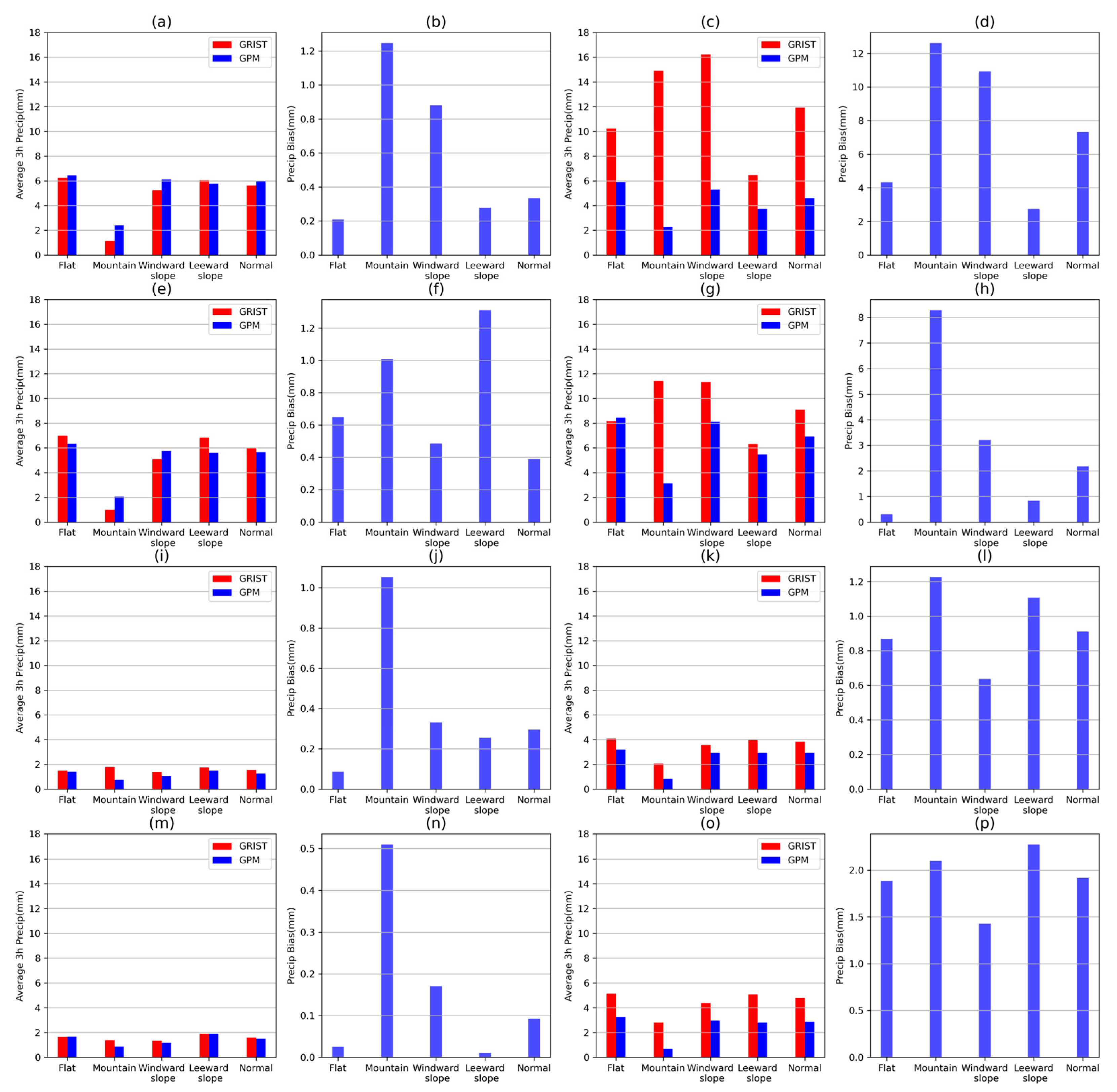
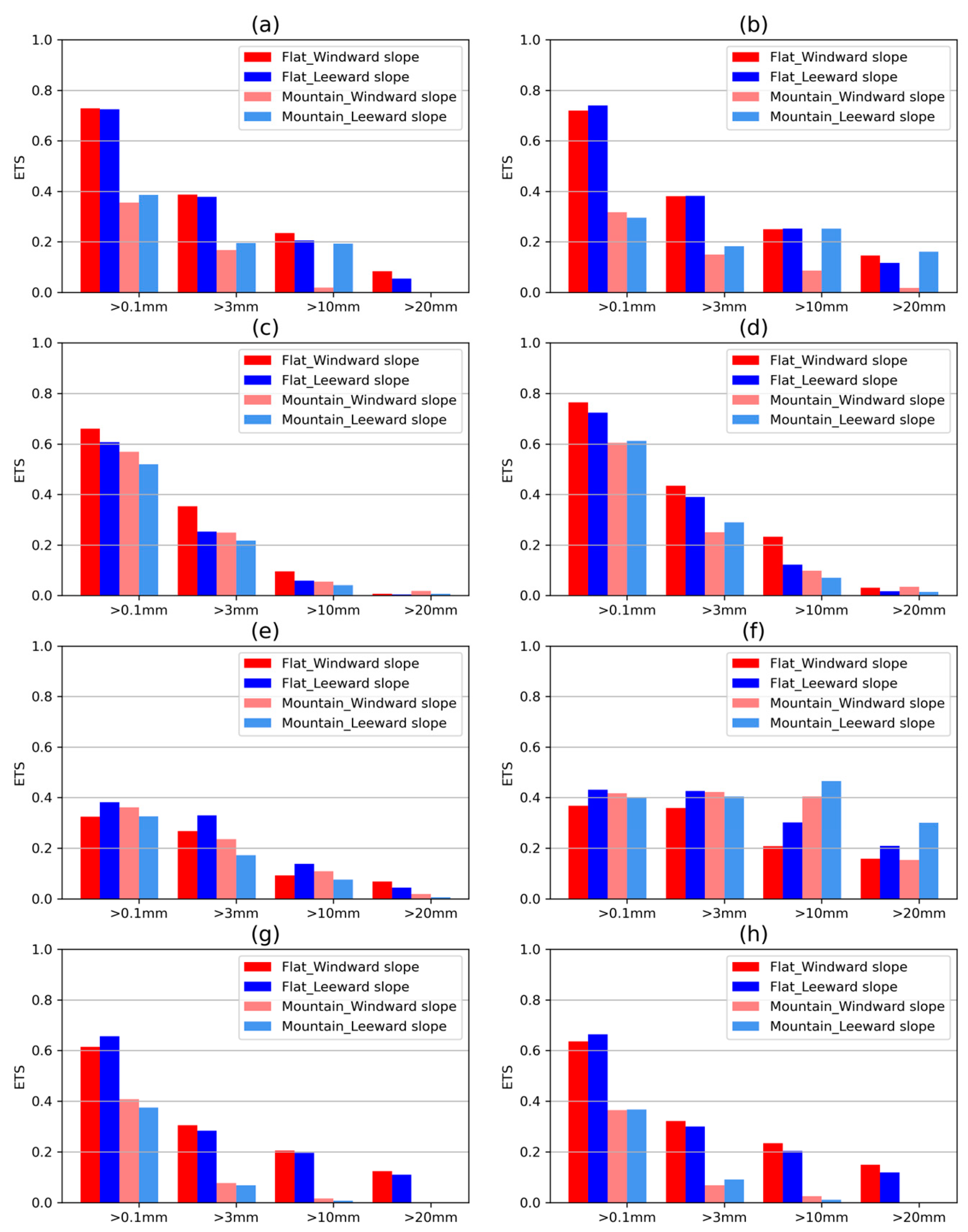

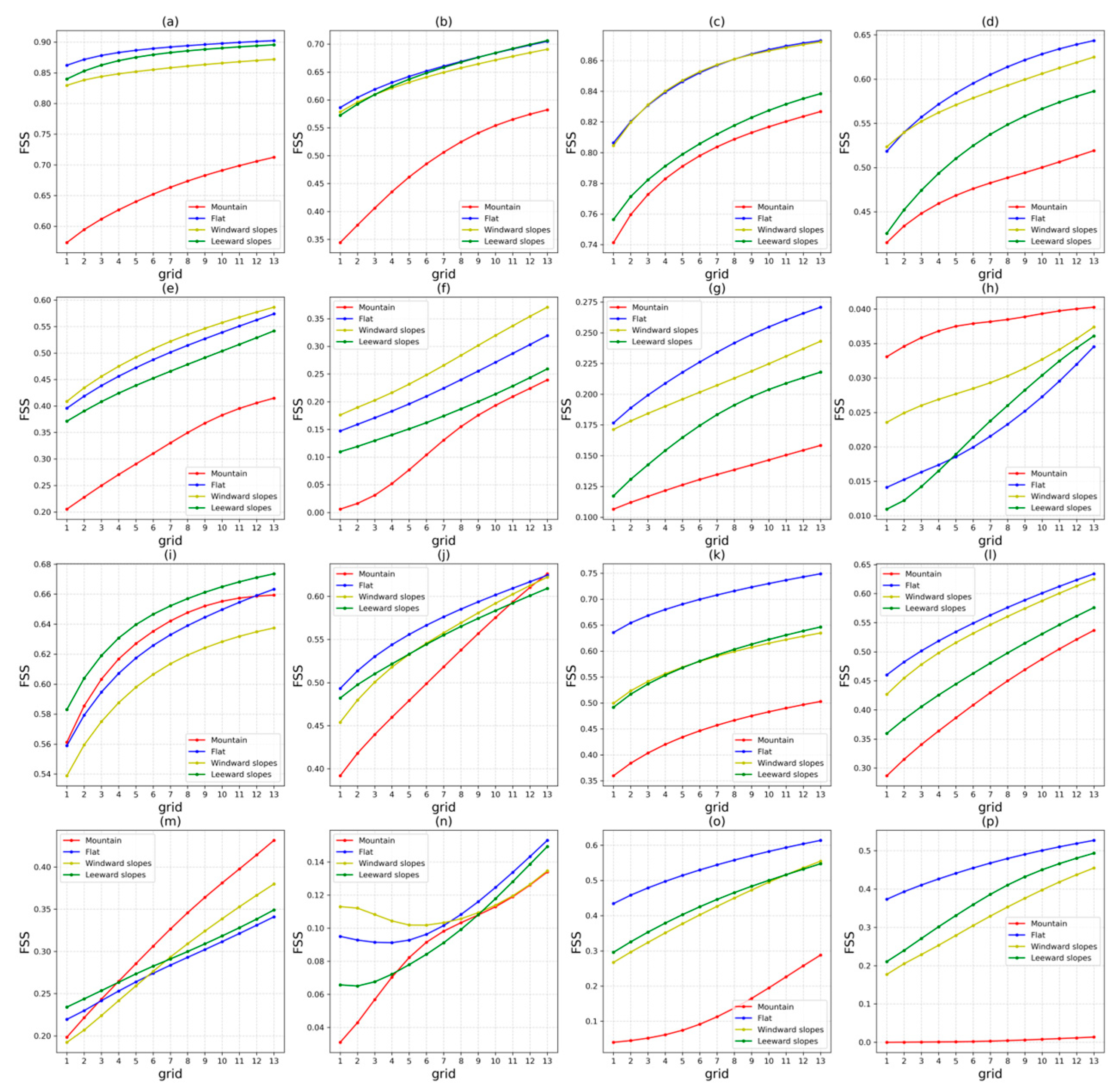
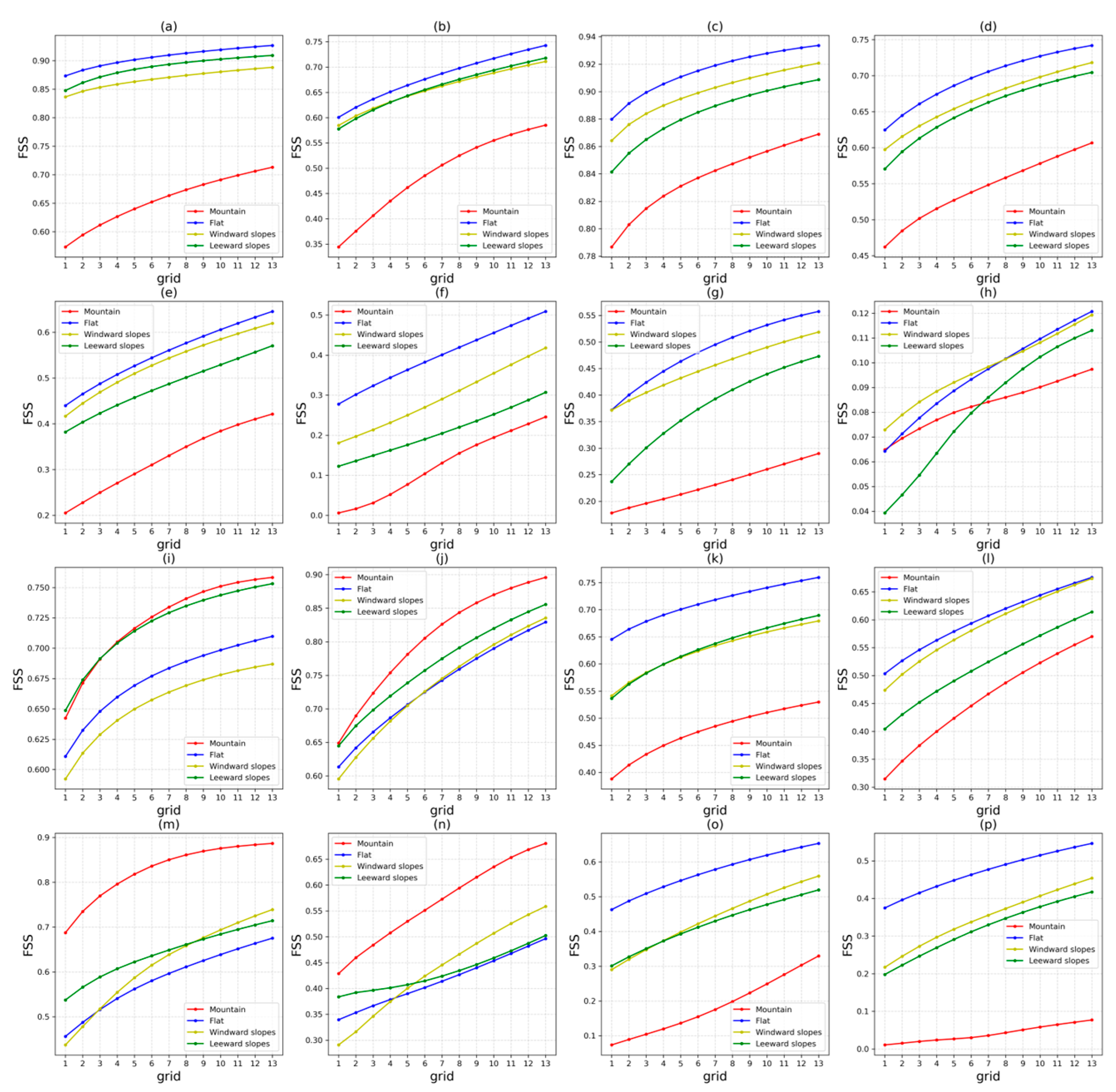
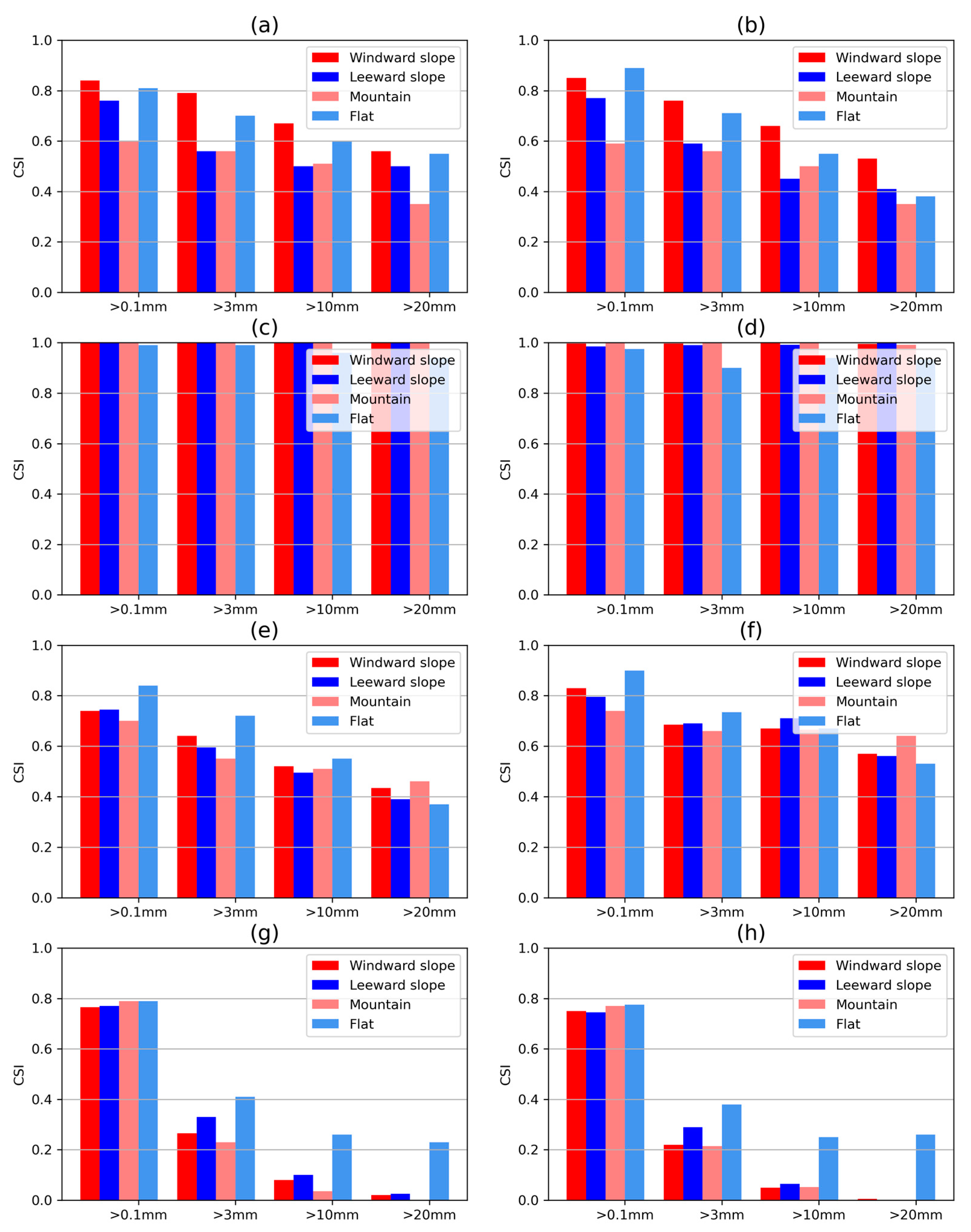
| Event | Period Averaged | 3 h Comparisons |
|---|---|---|
| HOTA (2017) | 0000 UTC 23 Aug. to 0000 UTC 24 Aug. | 3 h update frequency: 8 valid times total |
| LEKIMA (2019) | 1200 UTC 9 Aug. to 0000 UTC 11 Aug. | 3 h update frequency: 12 valid times total |
| HAGUPIT (2020) | 0000 UTC 3 Aug. to 0000 UTC 4 Aug. | 3 h update frequency: 8 valid times total |
| INFA (2021) | 1500 UTC 24 Jul. to 0300 UTC 26 Jul. | 3 h update frequency: 12 valid times total |
Disclaimer/Publisher’s Note: The statements, opinions and data contained in all publications are solely those of the individual author(s) and contributor(s) and not of MDPI and/or the editor(s). MDPI and/or the editor(s) disclaim responsibility for any injury to people or property resulting from any ideas, methods, instructions or products referred to in the content. |
© 2023 by the authors. Licensee MDPI, Basel, Switzerland. This article is an open access article distributed under the terms and conditions of the Creative Commons Attribution (CC BY) license (https://creativecommons.org/licenses/by/4.0/).
Share and Cite
Chen, X.-Z.; Ma, Y.-L.; Lin, C.-Q.; Fan, L.-L. Assessment of Typhoon Precipitation Forecasts Based on Topographic Factors. Atmosphere 2023, 14, 1607. https://doi.org/10.3390/atmos14111607
Chen X-Z, Ma Y-L, Lin C-Q, Fan L-L. Assessment of Typhoon Precipitation Forecasts Based on Topographic Factors. Atmosphere. 2023; 14(11):1607. https://doi.org/10.3390/atmos14111607
Chicago/Turabian StyleChen, Xu-Zhe, Yu-Long Ma, Chun-Qiao Lin, and Ling-Li Fan. 2023. "Assessment of Typhoon Precipitation Forecasts Based on Topographic Factors" Atmosphere 14, no. 11: 1607. https://doi.org/10.3390/atmos14111607
APA StyleChen, X.-Z., Ma, Y.-L., Lin, C.-Q., & Fan, L.-L. (2023). Assessment of Typhoon Precipitation Forecasts Based on Topographic Factors. Atmosphere, 14(11), 1607. https://doi.org/10.3390/atmos14111607






